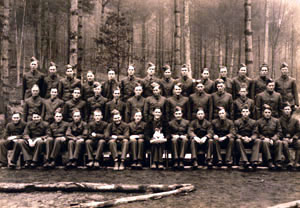
Civilian Conservation Corps (CCC)
On March 31, 1933, President Franklin D. Roosevelt signed legislation to create the Civilian Conservation Corps, the first of the New Deal agencies. The CCC employed young men and gave them an opportunity to develop new skills and prepare them for future employment as the nation recovered from the Great Depression.
Originally established as the “Emergency Conservation Work Program,” the CCC was renamed in 1937. Although there are no official records, estimates of the number of young men who participated in the nine-year program reach approximately three million. Congress extended the program to include African Americans, Native Americans, and World War I veterans. Enrollees performed a variety of conservation activities including reforestation, soil conservation, road construction, flood and fire control, and agricultural management. The CCC also completed a number of tasks associated with the development and construction of state and national parks. The CCC provided food, clothing, and shelter, as well as education, vocational training, and health care. The Department of Labor, the War Department, and the Department of Interior administered the CCC; state and local labor offices assisted with selection and enrollment procedures.
The CCC’s Fourth Corps area, District C, included Tennessee plus western North Carolina, northern Georgia, Alabama, and Mississippi. Organized on April 25, 1933, District C fielded forty companies, including three “Veteran White,” one “Veteran Colored,” two “Junior Colored,” and thirty-four “Junior White” camps. Tennessee supported eleven district headquarters located in Memphis, Union City, Jackson, Paris, Columbia, Nashville, Tullahoma, Cookeville, Chattanooga, Knoxville, and Johnson City and fifteen branch offices located in Dyersburg, Murfreesboro, McMinnville, Shelbyville, Clarksville, Springfield, Cleveland, LaFollette, Maryville, Loudon, Rockwood, Morristown, Elizabethton, Kingsport, and Bristol. The state’s first CCC company set up headquarters at Camp Cordell Hull near Limestone Cave in Unicoi County in 1933. By the following year, Tennessee sponsored thirty companies.
Enrollment was offered to single men between the ages of seventeen and twenty-eight; however, the reinstituted CCC of 1937 made enrollment available to men between the ages of seventeen and twenty-three. Applicants had to prove their marital status, provide evidence they had been unable to find employment for at least two months, and demonstrate that their families could not provide education or training comparable to that made available to members of the corps. Enrollees signed up for a minimum of six months, and few members participated for more than one or two years. The state’s motto, “Select, rather than collect,” reflected the high honor associated with participation in the CCC. Tennessee’s CCC boys earned thirty dollars per month, twenty-five dollars of which went to families or was deposited with the War Department until the corps member received his “honorable discharge.”
Tennessee’s total number of CCC companies reached its peak in July 1937, when the state supported forty-six camps. By the time the CCC disbanded, more than seventy thousand Tennesseans had served. In 1942 changing American ideas about the CCC and congressional pressure to end the program resulted in the agency’s dissolution, but in Tennessee, the CCC had completed work in seventeen state parks as well as in the Great Smoky Mountains National Park. The national success of the CCC is directly attributed to Roosevelt, who seldom compromised his values concerning the need for the agency and a national conservation movement.
Suggested Reading
John A. Salmond, The Civilian Conservation Corps, 1933-1942 (1967); Carroll Van West, The New Deal Landscape of Tennessee (2001)



